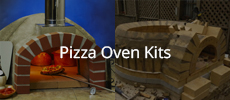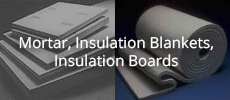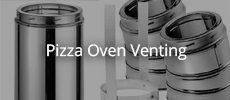These links may help
heat-break-to-do-or-not-to-do
thermal-breaks
I've always liked Mongo's ( mongota ) approach.
X
-
On my first oven, I just used a piece of cardboard to make the break; of course this eventually burned, leaving ash (a reasonable insulator) filling the gap. On my second oven I had a bunch of Nomex felt from my attempt at a door and placed that in the gap (though again the top mostly filled with ash). Either way, 1/8-1/4 inch is typical. Whatever you fill it with, you'll want the gap to go all the way down to the insulation, as the bricks don't only conduct heat at the surface.
Leave a comment:
-
13-1/2" is what I used on mine. I have a 42" oven, the landing is 13-1/2" deep. My landing arch dimensions with regards to the transitioning to the chimney anchor plate and chimney itself are in the link below. I start my fires on the landing and even after years of use there are no smoke or soot stains on the face of the oven opening. It draws quite well.
https://community.fornobravo.com/for...961#post431961
Leave a comment:
-
I did that on mine ONLY because of the design of my oven. My hearth slab outside the footprint of the dome is exposed to the elements and I didn't want rain saturating the slab, and then moisture from within the slab migrating up from below and into the insulation. For my build, the RedGard has worked out very well in terms of preventing water intrusion into the floor insulation from the hearth slab. But it's not a detail that needs to or should be included on all builds.Originally posted by dogshark58 View PostI have just cut my ceramic fibre board to size, it may have excellent insulation but I’m not impressed with the lose debris on the edges. I had read that painting Red Guard under the insulation is advisable especially in a wet climate like Ireland. Would painting the edges of the fibre board help in sealing the loose debris on the fibre board edges?
Best, Mongo
Leave a comment:
-
Having cut my insulation, I’m about to position it on the hearth. I will install weep holes and use mosaic tiles to support the insulation.
I plan to have a heat break between inner and outer arch. I have read about having a good width for a smoke collection area leading to the chimney. This will be a factor in determining the length of the landing.
I had planned to have a landing length of brick and a half ie about 13.5” from the joint of the inner/outer arch.
1. Does this sound ok.
2. Also would the length of a brick be sufficient to act as a smoke collection area leading to chimney?
The landing length will determine the positioning of the insulation on the hearth to commence the build and weep hole locations.
Leave a comment:
-
I have just cut my ceramic fibre board to size, it may have excellent insulation but I’m not impressed with the lose debris on the edges. I had read that painting Red Guard under the insulation is advisable especially in a wet climate like Ireland. Would painting the edges of the fibre board help in sealing the loose debris on the fibre board edges?
Leave a comment:
-
Thanks for the responses guys.
I had assumed to extend the floor proud of the dome bricks to allow for expansion and also not to leave small unstable brick cuts.
I take the point regarding not extending over the insulation. I had intended to have the insulation extend a fraction to accommodate brick expansion.
Finally, at the front of the landing is it normal to have a border of bricks cemented to the foundation to cover the exposed insulation / floor bricks?
Leave a comment:
-
IMHO, the floor bricks could be what us yanks call "proud" or extending beyond the edge of the dome especially if the oven is in an enclosure and the type of insulation you are doing. By having the floor bricks proud, the dome can sit on the floor bricks and you do not need to have the edges nearly as precise as the floor inside the dome. That said, I would not have the floor bricks extend past the floor insulation. So it depends on a lot of factors which way is best.
-
Should the brick floor extend beyond the dome? No, preferably the floor is trimmed to align with the outside of the first course. If the floor would stick out, then those parts would need to be insulated too, and that would be less practical.
Should the floor insulation extend beyond the dome? Many builders extend the floor insulation so that the dome insulation (the blanket) can rest on it. The other way around also works, but is a bit less practical.
Finishing the front of the landing: There's many options, I'll leave others with more experience to answer that. But you should definitely do *something* to cover exposed insulation.
-
I plan to have about 25mm (approx 1") of oven floor beyond the outside of the 1st course of dome bricks. Is this sufficient?
Also, should the insulation extend a little beyond the oven floor. I assume the weight of the floor bricks, dome insulation and outer shell keeps the floor bricks in place.
Finally, at the front of the landing is it normal to have a border of bricks cemented to the foundation to cover the exposed insulation / floor bricks?
Leave a comment:
-
The one-piece granite slab of our oven had the dome cut out. My brother-in-law got a nice round table out of it. Resting the entire oven on top of the granite is possible, I suppose, but seems a bit silly.
-
I was responding to this question by the OP:Originally posted by Pizzarotic View Post
OP said the insulation was going on top the granite.
Bricks can't be cemented to smooth granite. Heat proof silicone, maybe, but cement would not work.Originally posted by dogshark58 View PostOption 2.....Would cementing the outer row of bricks to the granite keep it stable or would this inhibit floor expansion....
-
OP said the insulation was going on top the granite.Originally posted by MarkJerling View Post
It would be impossible to cement bricks to and underlying layer of smooth granite..
-
It would be impossible to cement bricks to and underlying layer of smooth granite. Basically, you're proposing an oven that will try to slide around on a smooth granite surface. It would make far more sense to only use granite around the outside of your oven.Originally posted by dogshark58 View PostI am still at the planning stage though I have about 50% of my bricks cut before our Irish wet season started.
I intend covering my hearth with polished granite as an impervious layer on which my underfloor insulation will sit. As the granite comes in 1m square tiles I’ll place weep holes to permit drainage.
I would like some advice regarding insulation under the oven floor. From various pictures I see two options.- The insulation it trimmed to match the shape and size of the oven ie circular.
- The insulation and oven floor are rectangular and much wider than the finished dimensions of the oven.
Option 2, If I use this method do I need to have something around the outer layer of floor bricks to keep the oven floor from moving. Would cementing the outer row of bricks to the granite keep it stable or would this inhibit floor expansion. Do I need to allow for floor expansion?
Any suggestions as always welcome.
-
I’m not sure that granite is a suitable material as it does not like heat. Particularly if the granite slab is both under the oven and extends out past the outer rendered shell. The difference in thermal expansion between that part which is being heated and the cooler outer part in ambient temperature is sufficient to crack it. This is exactly the scenario I observed on an oven I was doing repairs on last year. I think I’ve also read the same from members reports on this forum. It would be better to cut the granite so it does not sit under the floor insulation IMO. The concrete slab can be sealed to prevent wicking moisture before placing the insulation board.Last edited by david s; 03-02-2022, 12:37 PM.





Leave a comment: